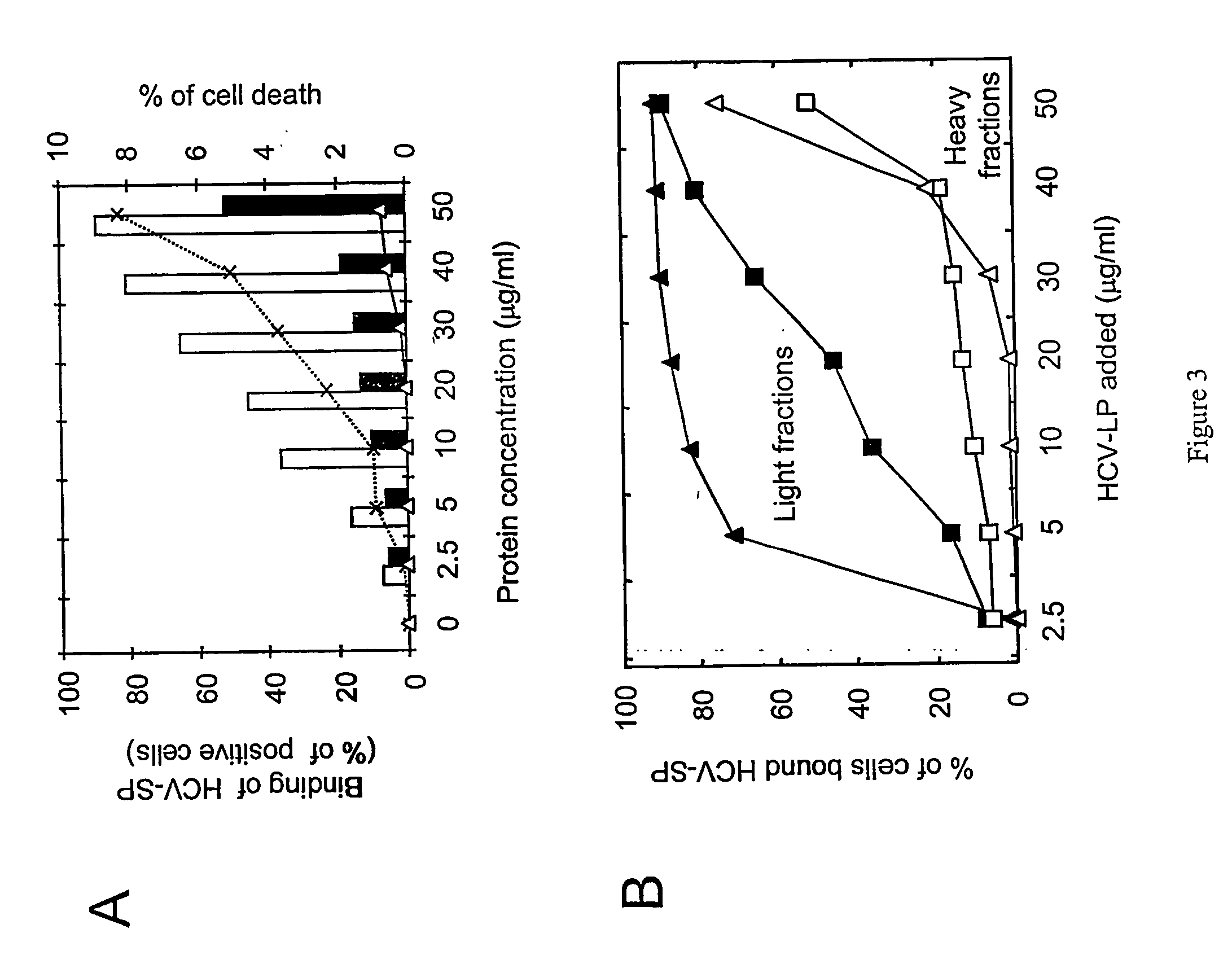Hepatitis c viral-like particle purification
a technology of viral particles and purification methods, applied in the field of hepatitis c viruslike particles, can solve the problems of severe liver damage, autoimmune disorders, and inability to know whether these proteins form heterodimers at the surface of viral particles, and achieve similar or higher inhibitory effects, reduce hcv-sp binding, and reduce hcv-sp binding
- Summary
- Abstract
- Description
- Claims
- Application Information
AI Technical Summary
Benefits of technology
Problems solved by technology
Method used
Image
Examples
example 1
Baculoviruses Expressing HCV Proteins
[0092] Two recombinant baculoviruses expressing the structural proteins of HCV derived from 1a genotype (H77 strain) were generated (FIG. 1). These two constructs express core, E1 and E2-p7 or core, E1 and E2 without p7.
[0093] A plasmid containing an infectious HCV clone of the 1a genotype H77 strain, p90 / HCV.FL-long pU (gift of M. E. Major & S. M. Feinstone; FDA; Bethesda, Md.), was used as a template to generate two recombinant baculoviruses coding for the structural HCV proteins: core, E1 and either E2 / p7+ (Bac.HCV-S) or E2 / p7− (Bac.HCV-S / p7−). The Bac.HCV.S has an additional 63 nt of the amino terminal part of NS2. This plasmid was digested with Stu I and Tth111 I, releasing a DNA fragment (nt 278-2831) corresponding to core, E1 and E2 / p7+ proteins, which was subcloned between the Stu I-Xba I sites of a pFastBac plasmid, allowing its expression under the control of a polyhedrin promoter (pFB90S). A second DNA fragment (nt 1814-2579) was gen...
example 2
First Method of Purification—HCV Structural Proteins (HCV-SP)
[0096] Sf9 cells were grown at 27° C. in Sf900 medium (Gibco-BRL / Life Technologies, Gaithersburg, Md.) and were infected with recombinant baculovirus at multiplicity of infection (MOI) of 5 in a 500-ml Erlenmeyer flask, and cells were harvested at 3 days post-infection. All purification steps were carried out at 4° C. on ice. Cells were harvested (3,000 rpm for 15 min), washed once in 10 mM Tris-HCl pH 7.4, 150 mM NaCl, 1 mM CaCl2 (TNC) buffer containing 1 mM Pefabloc SC and a cocktail of EDTA-free protease inhibitors (Roche, Indianapolis, Ind.), and finally resuspended at 1×107 cells / ml in TNC buffer containing 0.25% digitonin and protease inhibitors (cf. above). Cells were homogenized, and placed on ice for 4 hr with gentle agitation, and centrifuged at 30,000×g for 45 min. The supernatant was collected, precipitated with 10% PEG 8000 and 0.15 M NaCl for 2 hr, and pelleted at 10,000 rpm for 30 min at 4° C. The pellet wa...
example 3
Characterization of HCV-SPs
[0097] The fractions collected from the sucrose gradients, as described in Example 3, were analyzed for the presence of E1, E2 and core proteins by both ELISA and Western blot. E2 ELISA was performed as described: a 96-well plate was coated with 100 μl (20 μg / ml in PBS) of GNA (lectin from Galanthus nivalis) at 37° C. for 3 hr. To prevent non-specific binding, 150 μl of 4% goat serum (in 5% skim milk-PBS) was added and incubated for 3 hr at room temperature. Samples containg HCV-SPs were diluted in 5% skim milk-PBS, added to each well and incubated at 4° C., overnight. Anti-E2 monoclonal antibody (mAb AP33, 100 μl, 6 μg / ml) was added and plate was incubated for 3 hr at 37° C. Peroxidase labeled goat anti-mouse IgG (at a dilution of 1 / 1000) was then added and incubated for 1 hr at 37° C. Bound antibodies were detected by adding ABTS Microwell Peroxidase Substrate System and measured on an ELISA reader at an optical density of 405 nm (OD 405 nm). Plate was ...
PUM
| Property | Measurement | Unit |
|---|---|---|
| diameter | aaaaa | aaaaa |
| diameter | aaaaa | aaaaa |
| density | aaaaa | aaaaa |
Abstract
Description
Claims
Application Information
 Login to View More
Login to View More - R&D
- Intellectual Property
- Life Sciences
- Materials
- Tech Scout
- Unparalleled Data Quality
- Higher Quality Content
- 60% Fewer Hallucinations
Browse by: Latest US Patents, China's latest patents, Technical Efficacy Thesaurus, Application Domain, Technology Topic, Popular Technical Reports.
© 2025 PatSnap. All rights reserved.Legal|Privacy policy|Modern Slavery Act Transparency Statement|Sitemap|About US| Contact US: help@patsnap.com



